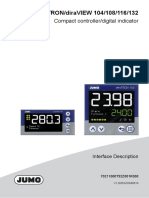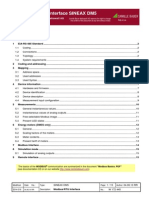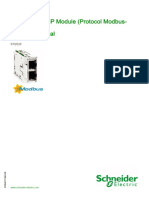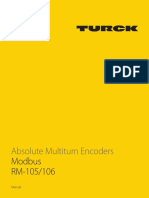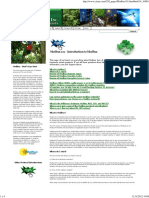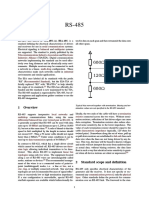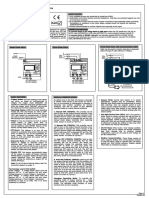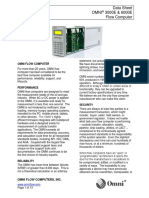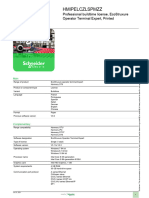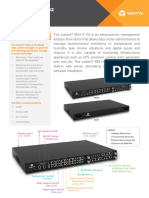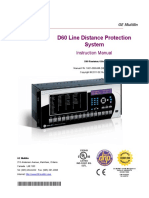EKC Modbus Danfoss
Uploaded by
marco1402EKC Modbus Danfoss
Uploaded by
marco1402Design guide
DATA COMMUNICATION MODBUS RS 485 RTU
For product type - EKD / EIM controllers
This User guide document provides general
information on the setup of Modbus RS-485
networks and explains how to configure the
communication between EKD/EIM and a system
controller, using the Modbus RTU.
Features • Simplicity
• Standard Ethernet
• Open protocol
• Availability on many devices
© Danfoss | DCS (sw) | 2015.10 DKRCC.PS.R00.A1.02 | 520H10468 | 1
Design guide | Data Communication Modbus RS485 RTU
Part 1 - Hardware network specification
Introduction . . . . . . . . . . . . . . . . . . . . . . . . . . . . . . . . . . . . . . . . . . . . . . . . . . . . . . . . . . . . 3
References . . . . . . . . . . . . . . . . . . . . . . . . . . . . . . . . . . . . . . . . . . . . . . . . . . . . . . . . . . . . . 3
Definitions and abbreviations . . . . . . . . . . . . . . . . . . . . . . . . . . . . . . . . . . . . . . . . . . . 3
Wiring . . . . . . . . . . . . . . . . . . . . . . . . . . . . . . . . . . . . . . . . . . . . . . . . . . . . . . . . . . . . . . . . . . 4
RS-485 specific . . . . . . . . . . . . . . . . . . . . . . . . . . . . . . . . . . . . . . . . . . . . . . . . . . . . . . . . . 5
Repeater . . . . . . . . . . . . . . . . . . . . . . . . . . . . . . . . . . . . . . . . . . . . . . . . . . . . . . . . . . . . . . . . 5
Topology . . . . . . . . . . . . . . . . . . . . . . . . . . . . . . . . . . . . . . . . . . . . . . . . . . . . . . . . . . . . . . . 6
Cable connections . . . . . . . . . . . . . . . . . . . . . . . . . . . . . . . . . . . . . . . . . . . . . . . . . . . . . . 7
Termination . . . . . . . . . . . . . . . . . . . . . . . . . . . . . . . . . . . . . . . . . . . . . . . . . . . . . . . . . . . . . 8
Conductors in a daisy chain . . . . . . . . . . . . . . . . . . . . . . . . . . . . . . . . . . . . . . . . . . . . . 8
Ground connections . . . . . . . . . . . . . . . . . . . . . . . . . . . . . . . . . . . . . . . . . . . . . . . . . . . . 8
Part 2 - Software specification and configuration
Introduction of RS-485 Communication . . . . . . . . . . . . . . . . . . . . . . . . . . . . . . . . . . 9
Modbus RTU message. . . . . . . . . . . . . . . . . . . . . . . . . . . . . . . . . . . . . . . . . . . . . . . . . . . . 10
Modbus RTU message structure . . . . . . . . . . . . . . . . . . . . . . . . . . . . . . . . . . . . . . . . . 10
How to access parameters . . . . . . . . . . . . . . . . . . . . . . . . . . . . . . . . . . . . . . . . . . . . . . . 11
RS485 bus function codes overview . . . . . . . . . . . . . . . . . . . . . . . . . . . . . . . . . . . . . . 11
EKD examples . . . . . . . . . . . . . . . . . . . . . . . . . . . . . . . . . . . . . . . . . . . . . . . . . . . . . . . . . . . 11
EIM examples . . . . . . . . . . . . . . . . . . . . . . . . . . . . . . . . . . . . . . . . . . . . . . . . . . . . . . . . . . . 14
Appendix 1 EIM Modbus conversion table . . . . . . . . . . . . . . . . . . . . . . . . . . . . . . . . 16
Appendix 2 EKD Modbus table . . . . . . . . . . . . . . . . . . . . . . . . . . . . . . . . . . . . . . . . . . . . 17
Appendix 3 Modbus exception code . . . . . . . . . . . . . . . . . . . . . . . . . . . . . . . . . . . . . . 18
Appendix 4 Modbus tool . . . . . . . . . . . . . . . . . . . . . . . . . . . . . . . . . . . . . . . . . . . . . . . . 18
© Danfoss | DCS (sw) | 2015.10 DKRCC.PS.R00.A1.02 | 520H10468 | 2
Design guide | Data Communication Modbus RS485 RTU
Introduction Making a network means to connect devices together with a communication bus. But to make
reliable and high performance networks strict rules must be followed.
References Modbus specifications, Modbus.org
EIA-485 RS-485 fieldbus specification
Definitions and RTU Remote Terminal Unit
abbreviations SW Software
HW Hardware
AWG American Wire Gauge
EKE / EIM / EKD Superheat Controller/driver
Parameter The parameter number indicates the number of a given parameter.
Value Indicates the factory settings.
Type Group. Group (number) indicates the group the relevant parameter
belongs to. The group number is only of importance for presentation
in AKM PC software.
PNU Short for Parameter NUmber. In Modbus terminology it corresponds to the
register number which is also often referred to as the offset. The PNU numbers
can have values in the range from 1 to 65535. The corresponding Modbus
address is found by subtracting 1 from the PNU number. For instance PNU
number 117 would correspond to Modbus address 116.”
© Danfoss | DCS (sw) | 2015.10 DKRCC.PS.R00.A1.02 | 520H10468 | 3
Design guide | Data Communication Modbus RS485 RTU
Wiring
Wiring characteristics The wires should have the following characteristics:
• Characteristic impedance: 120 Ohm +/- 10%;
• Specific resistance depending on network length.
• Cable must be with Screen if the bus cable exceeds 3m.
• The cable is connected from controller to controller and no branches are allowed on the cable
• Each shield must be grounded at one side only.
Wiring types Two types of wires can be used based on required ruggedness:
1. Twisted pair with ground: short leads, no power lines in proximity.
2. Twisted pair + ground and shield: long leads, disturbed environment.
Recommendations When choosing a transmission line for RS-485, it is necessary to examine the required distance of the
(Source Modbus.org) cable and the data rate of the system.
An RS485-Modbus must use a balanced pair (for D+-D-) and a third wire (for the Common/Gnd).
For RS485-Modbus, Wire Gauge must be chosen sufficiently wide to permit the maximum length
(1000 m ). AWG 22 is always sufficient for the Modbus Data.
Category 5 cables may operate for RS485-Modbus, to a maximum length of 600m.
For the balanced pairs used in an RS485-system, a Characteristic Impedance with a value higher than
100 Ohms may be preferred, especially for 19200 and higher baud rates.
Use one twisted pair of conductors for connecting the differential signals and use another conductor
(for example a second twisted pair) for connecting the ground.
Modbus Modbus connections
D+ (A+) EKE EKD EIM
D– (B–) D+ A+ TxD+
D- B- TxD-
GND
Danfoss
84N404.10 Gnd Gnd 1)
1) Gnd has been omitted from EIM.
Fig. 1 Connection example
Note! Connection of a twisted cable in a 2-wire Modbus system may cause damages.
© Danfoss | DCS (sw) | 2015.10 DKRCC.PS.R00.A1.02 | 520H10468 | 4
Design guide | Data Communication Modbus RS485 RTU
RS-485 specific The RS-485 consists of three wires:
• RS-485-A (D+);
• RS-485-B (D-);
• GND.
The two wires RS-485-A (D+) and RS-485-B (D-) propagate a differential communication signal.
In addition there is the ground wire for the common mode voltage reference.
The recommended maximum Modbus cable length between the EKE(/EKD/EIM) and the system
controller should not exceed 1000 meters (3300 feet).
Wire length
Length (m) Max. baudrate Min. Wire size Suggested types
1000 125 K AWG22 Belden 3106A / 3107A
RS-485: Controllers The maximum number of controllers that can be connected to a Modbus line is 120.
One repearter must be added for every 32 controllers. If the data communication cable runs through
an electrically noisy environment which impairs the data signal, one or more repeaters must be
added to stabilize the signal.
Repeater A repeater has no address.
A repeater from the company "Phoenix" can be used:
Danfoss code no. = 084B2240 (type AKA 222).
Modbus
Master Slaves
84B3210.10
Danfoss
max. 1000 m
Modbus Repeater
Slaves Slaves
84B3210.10
Danfoss
Master
© Danfoss | DCS (sw) | 2015.10 DKRCC.PS.R00.A1.02 | 520H10468 | 5
Design guide | Data Communication Modbus RS485 RTU
Topology
Standard topology The controller should be connected according to the bus topology. That means that the communica-
tion cable is wired from one controller to the next without branches.
Three conductors
T T
001 002 n
Three conductors + shiels
T T
001 002 n
84B3202.10
Danfoss
Legend
Shield
Communication cable, 120 Ω impedance
T 120 Ω termination
Recommendations Avoid making stubs on the line.
If stubs are present in the network they should be kept as short as possible
(<0.3 m at 1 Mbit; <3 m at 50 kbit).
84B3204.10
Danfoss
Field BUS
84B3203.10
Danfoss
Stub
- 0.0.0. - 0.0.0.
Fig Fieldbus with ‘’STUB” 01 Fig Fieldbus with ‘’STUB” 02
Min 10-15 cm
Field BUS Field BUS
84B3206.10
Danfoss
84B3205.10
Danfoss
Fig Star topology Fig Fieldbus wire
Do not use a ‘STAR topology’ Do not route the fieldbus wires close to power
lines or wires leading to heavy loads
© Danfoss | DCS (sw) | 2015.10 DKRCC.PS.R00.A1.02 | 520H10468 | 6
Design guide | Data Communication Modbus RS485 RTU
Cabinet mounting Route the wires close to the devices sepa-
rating the twisted wires only for the short-
est possible distance needed for inserting
them into the screw terminals.
Max. 5 cm
84B3207.10
Danfoss
When controllers are installed in a cabinet,
internal cable ducting must also comply with
the relevant requirements. Use this cable
ducting when one or more controllers are
installed in a cabinet. The short connections
between controllers must also be of the cor-
rect cable types.
Fig Wires close
• Do not use different wire types on a network, even
for short distances.
• Do not route through terminal blocks
84B3209.10
Danfoss
Note! On running/bundling the communica-
tion wires very close to high power wires or
other sources of electrical noise (frequency
converters etc.) could cause electromagnetic
interference. Therefore, try to separate the
wires from such sources if possible. - 0.0.0. - 0.0.0. - 0.0.0.
Keep a distance to relays, their cables and other things
emitting electric noises
Cable connection and Connect the RS-485 cable to the dedicated terminals of the EKD controller:
termination Modbus • Negative (B-) polarity wire to terminal 9
• Positive (A+) polarity wire to terminal 10
• Cable screen to terminal 11.
For EIM , connect it as shown in the figure to terminal COM
EIM
Modbus to master
controller
TxD- TxD+
D
PWR
COM
PO
S2
S4
ADR
EEV
84B3208.10
80G168.10
Danfoss
Danfoss
© Danfoss | DCS (sw) | 2015.10 DKRCC.PS.R00.A1.02 | 520H10468 | 7
Design guide | Data Communication Modbus RS485 RTU
Termination There must be always two terminations on the network, one at each bus end.
The termination can be installed by connecting a 120 Ohm ± 10 % resistor between D+ and D-
for RS-485.
Here is shown a picture of how a Modbus network is typically terminated. The resistors are in this
picture called LT (Line Termination) and are typically 120 Ohm.
The pull up and pull down are usually built into the master on the Modbus. They are not built in
Danfoss controllers i.e EIM 336, EKD 316.
Master 5V
D
R
Pull up
D+
LT Ballanced Pair LT
D–
Pull down
Common
R R
D D
Figure. Two wire bus trophology
80G169.10
Slave 1 Slave 2
Danfoss
Conductors in a The wires are looped from device to device
daisy chain D+ is connected to D+
D- is connected to D-
In other words, Start Node (with termination resistor) from Node x to Node Y …. to End Node (with
Termination Resistor)in such a way that the polarity of the wires matches with the polarity of the
controller terminals.
Conducters
Modbus
84B3212.10
Danfoss
D+ D- D+ D- D+ D-
Shield (drain) should only be connected in one end, not both ends.
In case of EIM, this is how it is done. The communication line in PWR and COM are internally connected.
RS485 + RS485 +
R = 120 Ohm
Master controller Min. 0.25 Watt
PWR
COM
PWR
COM
80G165.10
RS485 -
Danfoss
RS485 -
EIM slave 1 EIM slave 2
Note! If two EIMs are connected remember to remove the addressing jumper on one of the EIMs.
Ground connections There must be a clean ground connection between all devices connected in the network.
In unisolated controller like EKD and EIM, if grounding is required , it should strick followed the
guideline as explained on section 3.1
Note! Be careful when connecting the bus to devises that have non isolated communication interfaces. If
the units are tied to different ground potentials, this may lead to communication problems or even to
damage to the units!
© Danfoss | DCS (sw) | 2015.10 DKRCC.PS.R00.A1.02 | 520H10468 | 8
Design guide | Data Communication Modbus RS485 RTU
Part 2 Software specification and configuration
Introduction This Chapter explains how to configure the communication between a EKE(/EKD/EIM) and a system
controller, using the Modbus RTU (Remote Terminal Unit) protocol. For detailed information about
Modbus communication, refer to Modbus Application Protocol Specifications V1.1b from
www.modbus.org
RS-485 Communication The Electronics Industry Association (EIA) established the RS-485 standard as a guide for developing a
multi-drop, bi-directional communication network.
RS-485 systems can be implemented using two-wires or four-wires modes. Danfoss uses the two-
wires system with shield. With the two-wires system, communication is half-duplex (cannot transmit
and receive at the same time).
The Modbus line uses one twisted–pair line – two wires twisted around themselves. This is known as
balanced data transmission. The signal on one wire is ideally the exact opposite of the signal on the
second wire. In other words, if one wire is transmitting a high, the other wire will be transmitting the
low, and vice versa. Since RS-485 is a multipoint communication system, all devices are connected to
the single twisted-pair cable.
The RS-485 system uses master/slave architecture, where each slave device (EKE/EKD/EIM) ) has its
unique address and responds only to requests packets addressed to this device. The requests packets
are generated by the master (system controller), which periodically polls all connected slave devices.
Data travels over the single line in both directions.
A basic RS-485 system requires an I/O driver with differential outputs and an I/O receiver with dif-
ferential inputs. Since the signal is transferred via a twisted pair of wires, if noise or interference is
introduced into the line, the voltage difference (between twisted pair wires) of this interference
is almost zero. Because the input to the receiver is differential, this interference is eliminated. Differ-
ential inputs also ignore different earth potentials of the transmitter and the receiver.
© Danfoss | DCS (sw) | 2015.10 DKRCC.PS.R00.A1.02 | 520H10468 | 9
Design guide | Data Communication Modbus RS485 RTU
Modbus RTU message The controllers are set up to communicate on the Modbus network using RTU (Remote Terminal Unit)
mode, with each byte in a message containing consisting of 11 bit. The format for each byte is shown
below.
Start bit Date byte Stop Parity Stop
Cooling system 8-bit binary, hexadecimal 0–9, A–F. Two hexadecimal characters contained
in each 8-bit field of the message
Bits Per Byte 1 start bit
8 data bits, least significant bit send first
1 bit for even/odd parity; no bit for no parity
1 stop bit if parity is used; 2 bit if no parity
Error check field Cylindric Redundance Check (CRC)
Danfoss controller follows the standard modbus communication with the following defaults :19200
Baudrate, Even parity and one stop bit.
In EIM/EKD, communication frequency (baudrate) can be one of the following: 9600 baud, 19200
baud and 38400 baud.
The only available fixed communication setting in EKD is 8 data bit, EVEN parity and 1 stop bit.
The default unit address is 240 which, can be changed using parameter “03 unit address”. Whereas a
wide range of selection bits are available in EIM modbus , check the product manual for detail.
Modbus RTU message A typical message frame is shown below.
structure
Start Address Sunction Data CRC check End
Start 8 bits 8 bits N x 8 bits 16 bits end
Example
Slave Function H1 Byte Lo byte NumRegs
Address Code Address Adress CRC
Hi Lo
A5 03 00 10 00 02 DC EA
How to access parameters The PNU (Parameter Number) is translated from the register address contained in the Modbus read
or write message. For detail check the section ‘Example’
When addressing holding registers on Modbus, the range of valid addresses is 0-65535 (0x0000 to
0xFFFF). In the documentation they are however often described in two different ways.
The first is using register numbers instead of addresses. By this convention the range of valid register
numbers is 1-65536, and the register address 0 is refered to as register number 1. Danfoss follows this
convention so when reading the PNU (Parameter Number) 117, the actual request asks for data from
address 116. So address = PNU – 1.
The second convention defines seperate ranges for different types of registers (coils, discrete inputs,
input register and holding registers). The number of available registers were originally limited to
10000 for each type, and in order to easily distinguish between the register types, in manuals etc.,
each type was assigned a part of the numbering range. In this way holding registers were numbered
from 40001 to 50000. The address range is however the same as before so the first holding register
with register number 40001 still is addressed on Modbus as address 0. So address = register number –
40001. This convention was introduced by the company Modicon and is therefore often referred to as
the Modicon convention.
Note! Modicon conventionway of addressing is available in EIM 336/316 controller only.
© Danfoss | DCS (sw) | 2015.10 DKRCC.PS.R00.A1.02 | 520H10468 | 10
Design guide | Data Communication Modbus RS485 RTU
RS485 bus function EKD/EIM RS485 Function code Comment
codes overview
Read PNU 0x03 Read holding registers
Write PNU 0x06 Write Single PNU/holding register only
Example The following examples illustrate various Modbus RTU commands in EKD
Note! 1. Requests are shown in blue and the hexadecimal representation of the data on the Modbus .
2. Responses are shown in green. The text in green is an interpretation of the response.
Action Description
Setup Switching the Main switch OFF/ON.
1 = Set “r12 Main switch ” PNU 117 to 0 (using address 240).
2 = Set “r12 Main switch ” PNU 117 to 1 (using address 240).
Result Verify that the EKD respond the Modbus master with an accept message.
Conclusion Writing r12 (PNU 117) to 0
[F0][06][00][74][00][00][DC][F1]
[F0][06][00][74][00][00][DC][F1] – Slave acknowledges
Writing r12 (PNU 117) to 1
[F0][06][00][74][00][01][1D][31]
[F0][06][00][74][00][01][1D][31] – Slave acknowledges
Action Description
Setup Setting up the Superheat maximum parameter n09
1 = Write “r12 Main switch ” PNU 117; Set it to 0.
2 = Write “n09 Max. SH “ PNU 3015; Set to 60.
3 = Read “n09 Max. SH ” PNU 3015; veryfying step 2.
Result Reading n09 max. SH i.e. PNU 3015 must be 60.
Conclusion Write r12 (PNU 117) to 0
[F0][06][00][74][00][00][DC][F1]
[F0][06][00][74][00][00][DC][F1] – Slave acknowledges
Reading PNU 3015
[F0][03][0B][C6][00][01][73][32]
[F0][03][02][00][64][C4][7A] – Slave responds 100
Writing PNU 3015 to 60
[F0][06][0B][C6][00][3C][7E][E3]
[F0][06][0B][C6][00][3C][7E][E3] – Slave acknowledges
Reading PNU 3015 again
[F0][03][0B][C6][00][01][73][32]
[F0][03][02][00][3C][C5][80] – Slave responds 60
© Danfoss | DCS (sw) | 2015.10 DKRCC.PS.R00.A1.02 | 520H10468 | 11
Design guide | Data Communication Modbus RS485 RTU
Example The following examples illustrate various Modbus RTU commands in EKD
Note! 1. Requests are shown in blue and the hexadecimal representation of the data on the Modbus .
2. Responses are shown in green. The text in green is an interpretation of the response.
Action Description
Setup Changing the device address
1 = Read “o03 Unit addr. ” PNU 2008 using address: 240.
2 = Set “o03 Unit addr. “ PNU 2008 to 239
Result 1 = Verify that it’s possible to use address 240.
2 = Verify that it’s possible to use address 239.
Conclusion Reading PNU 2008 from ID 240
[F0][03][07][D7][00][01][20][67]
[F0][03][02][00][F0][C5][D5] – Slave responds 240
Setting PNU 2008 to 239 on ID 240
[F0][06][07][D7][00][EF][6C][2B]
[F0][06][07][D7][00][EF][6C][2B] – Slave acknowledges
Reading PNU 2008 from ID 240
[F0][03][07][D7][00][01][20][67]
No response since the address is changed
Reading PNU 2008 from ID 239
[EF][03][07][D7][00][01][22][08]
[EF][03][02][00][EF][11][DF] – Slave responds 239
Action Description
Setup Reading Evaporator Pressure
1 = Read “u25 EvapPress Pe ” PNU 2543 using Modbus function code 0x03.
2 = Read “u25 EvapPress Pe ” PNU 2543 using Modbus function code 0x04.
Result Note: Read 0x04 function is only available in some selective danfoss controllers.
1 & 2 = Both Modbus commands responds with the same answer.
Conclusion Reading PNU 2543 with function code 03
[F0][03][09][EE][00][01][F2][82]
[F0][03][02][00][87][85][F3] – Slave responds 135
Reading PNU 2543 with function code 04
[F0][04][09][EE][00][01][47][42]
[F0][04][02][00][87][84][87] – Slave responds 135
Action Description
Setup Setting the controller in Manual mode
Set “o45 Manual OD%” PNU 2064 to 45.
Result Verify that the message and responds are:
Message: 0xA5 0x06 0x08 0x0F 0x00 0x2D 0x62 0x90
Responds: 0xA5 0x06 0x08 0x0F 0x00 0x2D 0x62 0x90
Conclusion Setting PNU 2064 to 45
[A5][06][08][0F][00][2D][62][90]
[A5][06][08][0F][00][2D][62][90] – Slave acknowledges
© Danfoss | DCS (sw) | 2015.10 DKRCC.PS.R00.A1.02 | 520H10468 | 12
Design guide | Data Communication Modbus RS485 RTU
Example The following examples illustrate various Modbus RTU commands in EKD
Note! 1. Requests are shown in blue and the hexadecimal representation of the data on the Modbus .
2. Responses are shown in green. The text in green is an interpretation of the response.
Action Description
Setup Examples explaining some illegal addressing and request with 0x03 (Read function) and 0x06 (Write).
Result The device must respond with illegal address or no response.
Conclusion Read 2 register starting from PNU 2008 from slave 240
[F0][03][07][D7][00][02][60][66]
[F0][83][02][91][02] - slave responds illegal address because 2009 is not defined
Read o03 unit address (PNU 2008) from slave 240 with wrong CRC
[F0][03][07][D7][00][01][20][68]
no response
Read PNU 2009 (undefined) from slave 240
[F0][03][07][D8][00][01][10][64]
[F0][83][02][91][02] - slave responds illegal address because 2009 is not defined
Write 2 to r12 main switch (PNU 117) on slave 240
[F0][06][00][74][00][02][5D][30]
[F0][86][03][53][92] - slave responds illegal data
Write 1 to PNU 118 (undefined) on slave 240
[F0][06][00][75][00][01][4C][F1]
[F0][86][02][92][52] - slave responds illegal address
Write 1 to r12 main switch (PNU 117) on slave 240 with wrong CRC
[F0][06][00][74][00][01][1D][31]
no response
Use function code 5 (undefined)
[F0][05][00][74][00][01][59][31]
[F0][85][01][D2][A3] - slave responds illegal function
© Danfoss | DCS (sw) | 2015.10 DKRCC.PS.R00.A1.02 | 520H10468 | 13
Design guide | Data Communication Modbus RS485 RTU
Example The following examples illustrate various Modbus RTU commands in EIM
Note! 1. Requests are shown in blue and the hexadecimal representation of the data on the Modbus .
2. Responses are shown in green. The text in green is an interpretation of the response.
Action Description
Setup Switching the Main switch OFF/ON (using address 165).
Conclusion Reading r12 main switch (PNU 117)
[A5][03][00][74][00][01][DD][34]
[A5][03][02][00][00][C9][9D] – Slave responds 1
Setting r12 main switch (PNU 117) to 1
[A5][06][00][74][00][01][11][34]
[A5][06][00][74][00][01][11][34] - Slave acknowledges
Setting r12 main switch (PNU 117) to 0
[A5][06][00][74][00][00][D0][F4]
[A5][06][00][74][00][00][D0][F4] – Slave responds 0
Action Description
Setup Setting up the Superheat Max. SH value on address 165
Conclusion Reading PNU 3015
[A5][03][0B][C6][00][01][7F][37]
[A5][03][02][00][A0][C9][E5] – Slave responds
Setting PNU 3015 to 100
[A5][06][0B][C6][00][64][73][1C]
[A5][06][0B][C6][00][64][73][1C] – Slave acknowledges
Reading PNU 3015 again
[A5][03][0B][C6][00][01][7F][37]
[A5][03][02][00][64][C8][76] – Slave responds 100
Action Description
Setup Changing EIM addressing from PNU to Modicon addressing
Conclusion Reading PNU 64200 (Modbus translation table)
[A5][03][FA][C7][00][01][1C][0B]
[A5][03][02][00][00][C9][9D] – Slave responds 0 (use PNU)
Setting PNU 64200 to 1
[A5][06][FA][C7][00][01][D0][0B]
[A5][06][FA][C7][00][01][D0][0B] – Slave acknowledges
Reading PNU 64200 again
[A5][03][FA][C7][00][01][1C][0B]
[A5][03][02][00][01][08][5D] – Slave responds 1
© Danfoss | DCS (sw) | 2015.10 DKRCC.PS.R00.A1.02 | 520H10468 | 14
Design guide | Data Communication Modbus RS485 RTU
Example The following examples illustrate various Modbus RTU commands in EIM
Note! 1. Requests are shown in blue and the hexadecimal representation of the data on the Modbus .
2. Responses are shown in green. The text in green is an interpretation of the response.
Action Description
Setup Switching the Main switch OFF/ON with Modicon addressing
Conclusion Setting Modicon 40011 (r12 main switch) to 0
[A5][06][00][0A][00][00][B0][EC]
[A5][06][00][0A][00][00][B0][EC] – Slave acknowledges
Reading Modicon 40011 (r12 main switch)
[A5][03][00][0A][00][01][BD][2C]
[A5][03][02][00][00][C9][9D] – Slave responds 0
Setting Modicon 40011 (r12 main switch) to 1
[A5][06][00][0A][00][01][71][2C]
[A5][06][00][0A][00][01][71][2C] – Slave acknowledges
Reading Modicon 40011 (r12 main switch) again
[A5][03][00][0A][00][01][BD][2C]
[A5][03][02][00][01][08][5D] – Slave responds 1
Action Description
Setup Reading the registers with Modicon addressing.
Conclusion Reading Modicon 40001 to 4004
[A5][03][00][00][00][04][5D][2D]
[A5][03][08][FC][E0][07][08][05][DC][00][00][4D][7A] – Slave responds -800, 1800, 1500, 0
© Danfoss | DCS (sw) | 2015.10 DKRCC.PS.R00.A1.02 | 520H10468 | 15
Design guide | Data Communication Modbus RS485 RTU
Appendix.1
EIM Modbus Conversion table
Parameter PNU Modicon Parameter PNU Modicon Parameter PNU Modicon
address address address
u25 EvapPress Pe 2543 40001 --- Tn Te 3116 40034 --- Rfg.Fac.A3 2550 40067
u20 S2 temp. 2537 40002 n20 Kp T0 3025 40035 --- Standby 20000 40068
u16 S4 air temp. 2531 40003 o18 Manual ctrl. 2075 40036 --- EKC Error 20001 40069
u27 Temp. S3 2545 40004 --- LOC Trig 50003 40037 --- S2 Error 20002 40070
--- Ctrl Status 3100 40005 --- LOC Reset 50004 40038 --- S4 Error 20004 40071
u26 EvapTemp Te 2544 40006 --- LOC Timer 50005 40039 --- Pe inp.error 20005 40072
u22 SuperheatRef 2535 40007 --- LOC SH Trig 50007 40040 --- No Rfg. Sel. 20006 40073
u21 Superheat 2536 40008 o03 Unit addr. 2008 40041 --- Valve error 20007 40074
u24 Opening % 2542 40009 --- Unit Addr. 2 2009 40042 --- Reset alarm 2046 40075
--- LOC Alarm 50006 40010 --- Modbus Baud 50060 40043 n37 Max steps 3032 40076
r12 Main switch 117 40011 --- ModbusParity 50061 40044 n38 Max StepsSec 3033 40077
--- Te Reference 3117 40012 --- ModbusStopB 50062 40045 n39 Start BckLsh 3034 40078
--- Comp Speed 3120 40013 --- ClosedValveT 3101 40046 n40 Backlash 3035 40079
ext EvapPress P0 2643 40014 --- Def Activate 50011 40047 n56 MotorCurrent 3051 40080
ext S2 temp 2644 40015 --- Def Hold OD 50008 40048 --- Factory2User 64060 40081
--- Diff MOP 3121 40016 --- Def HoldTi 1 50009 40049 --- User2Factory 64062 40082
r09 Adjust S2 113 40017 --- Def HoldTi 2 50010 40050 --- ControlState 3099 40083
o45 Manual OD% 2064 40018 --- Max SH shdw 64301 40051 --- LOC Tmr 3102 40084
n09 Max SH 3015 40019 --- Min SH shdw 64302 40052 --- Avg Opening 50033 40085
n10 Min SH 3021 40020 --- Tn SH shdw 64303 40053 --- OpenHighRes 50052 40086
n22 SH close 3027 40021 --- Alpha shdw 64304 40054 --- InputMeas 1 64050 40087
--- Tn SH 3103 40022 --- DefHold shdw 64305 40055 --- InputMeas 3 64052 40088
n11 MOP 3013 40023 --- SWVer shdw 64306 40056 --- Sw. version 2003 40089
--- SH Low 3105 40024 --- Startup 64307 40057 --- OrderNoLow 2011 40090
--- SH High 3106 40025 n15 StartUp time 3017 40058 --- OrderNoHigh 2015 40091
--- Gain High 3107 40026 n17 Start OD % 3012 40059 --- Avg KT0 Time 50020 40092
--- Gain Low 3108 40027 --- Off Min.OD % 64308 40060 --- Avg OD 3hour 50021 40093
--- Tau High 3109 40028 --- HwMainSwitch 64100 40061 --- Avg CompTime 50022 40094
--- Tau Low 3110 40029 o20 MinTransPres 2034 40062 --- AvgFltTime 3118 40095
--- Alpha 3111 40030 o21 MaxTransPres 2033 40063 --- Modbus trans 64200 Not avail-
--- Kp MOP 3113 40031 o30 Refrigerant 2551 40064 able in BO
address
--- Tn MOP 3114 40032 --- Rfg.Fac.A1 2548 40065 range
--- Kp Te 3115 40033 --- Rfg.Fac.A2 2549 40066
For detail description on the above parameters, please refer to the product user guide
© Danfoss | DCS (sw) | 2015.10 DKRCC.PS.R00.A1.02 | 520H10468 | 16
Design guide | Data Communication Modbus RS485 RTU
Appendix 2
EKD modbus table
Parameter PNU Parameter PNU
r05 Temp.unit 105 o18 Manual ctrl. 2075
r09 Adjust S2 113 o20 MinTransPres 2034
r10 Adjust S3 114 o21 MaxTransPres 2033
r12 Main switch 117 o30 Refrigerant 2551
A34 Battery low 10035 o45 Manual OD% 2064
n03 Valve type 3002 o56 Reg. type 2076
n04 Kp factor 3003 o61 Appl.mode 2077
n05 Tn seconds 3004 --- Rfg.Fac.A1 2548
n06 Td seconds 3005 --- Rfg.Fac.A2 2549
n09 Max SH 3015 --- Rfg.Fac.A3 2550
n10 Min SH 3021 --- Sw. version 2003
n11 MOP 3013 --- OrderNoLow 2011
n15 Start time 3017 --- Factory2User 64060
n17 MinOdAtStart 3012 --- Open Hyst. 64091
n18 Stability 3014 --- Close Hyst. 64092
n19 Kp min. 3024 --- Cal.Interval 64093
n20 Kp T0 3025 --- Alarm relay 2509
n21 SH mode 3026 --- Reset alarm 2046
n22 SH close 3027 u06 Analog input 2504
n32 ETS OD% Max 3023 u10 DI status 2002
--- Kp Actual 64090 u20 S2 Temp 2537
n37 Max steps 3032 u21 Superheat 2536
n38 Max StepsSec 3033 u22 SuperheatRef 2535
n39 Start BckLsh 3034 u24 Opening OD% 2542
n40 Backlash 3035 u25 EvapPres Pe 2543
n42 Comp. dir. 3037 u26 EvapTemp Te 2544
n43 Atten.Factor 3038 u27 Temp S3 2545
n44 TnT0 sec. 3039 P67 Open Hyst. 2181
n45 Min.Lim.Ref 3040 P68 Close Hyst. 2182
n56 MotorCurrent 3051 P69 OvD Enable 2183
--- EKC state 2007 P70 OvDProtect T 2184
o10 AI type 2027 P71 ForcedCloseT 2185
For detail description on the above parameters, please refer to the product user guide/installation guide.
© Danfoss | DCS (sw) | 2015.10 DKRCC.PS.R00.A1.02 | 520H10468 | 17
Appendix 3.
Modbus exception code For a full explanation of the structure of an exception code response, please refer to the Modbus
specification.”
Code Name Meaning
1 Illegal function This function code received in the query is not an allowable action for the server (or slave).
This may be because the function code is only applicable to newer devices and was not
implemented in the unit selected. It could also indicate that the server (or slave) is in the
wrong state to process a request of this type, for example because it is not configured and
is being asked to return register values.
2 Illegal data adress The data address received in the query is not an allowable address for the server (or slave).
More specifically, the combination of reference number and transfer length is invalid. For a
controller with 100 registers, a request with offset 96 and length 4 would succeed. a request
with offset 96 and length 5 will will generate exeption 02.
3 Illegal data value A value contained in the query data field is not an allowable value for the server (or slave).
This indicates a fault in the structure of the remainder of a complex request, such as that
the implied length is incorrect. It specifically does NOT mean that a data item submitted for
storage in the register has a value outside the expectation of the application program since
the Modbus protocol is unaware of the significance of any particular value of any particular
register.
4 Slave device failure An unrecoverable error occurred while the server (or slave) was attemptingto perform the
requested action.
Appendix 4. Following are some of the free modbus tool available on the Internet.
Please note that Danfoss doesn't provide any support on any third party modbus
communication tools.
Some non commercial free programs are:
ModbusMat - http://www.ataytugal.com/ModbusMat.htm
Modbus Request Pro:
http://forums.mrplc.com/index.php?app=downloads&showfile=465
Please note that there may be restrictions on the use of above stated modbus tools for commercial
applications
For your own notes
© Danfoss | DCS (sw) | 2015.10 DKRCC.PS.R00.A1.02 | 520H10468 | 18
You might also like
- Regulator PID KS 40 - KS 40-1 Interface DescriptionNo ratings yetRegulator PID KS 40 - KS 40-1 Interface Description78 pages
- 0323 Modbus For Dedicated Controls IO GBNo ratings yet0323 Modbus For Dedicated Controls IO GB96 pages
- An1702 St485eb For Emeter Applications StmicroelectronicsNo ratings yetAn1702 St485eb For Emeter Applications Stmicroelectronics11 pages
- GW1114-4DI (3IN1) - RJ-P (12-48VDC) DatasheetNo ratings yetGW1114-4DI (3IN1) - RJ-P (12-48VDC) Datasheet6 pages
- Technical Manual e DMCR v3 0 DocVersion 1-8-170723 (GB)No ratings yetTechnical Manual e DMCR v3 0 DocVersion 1-8-170723 (GB)16 pages
- Modbus Protocol User Manual: For Use With Procomm ConverterNo ratings yetModbus Protocol User Manual: For Use With Procomm Converter14 pages
- DC1010 DC1020 DC1030 DC1040: Communication Manual100% (1)DC1010 DC1020 DC1030 DC1040: Communication Manual28 pages
- SECTION 2.35: Esm System CommunicationsNo ratings yetSECTION 2.35: Esm System Communications12 pages
- Absolute Multiturn Encoders - Modbus - MA1032No ratings yetAbsolute Multiturn Encoders - Modbus - MA103222 pages
- WEG CFW500 Modbus Rtu Manual 2023-08-04No ratings yetWEG CFW500 Modbus Rtu Manual 2023-08-0434 pages
- Switchgear: Description Page Low Voltage Switchgear DE12-2 DE12-3No ratings yetSwitchgear: Description Page Low Voltage Switchgear DE12-2 DE12-314 pages
- CP1L-EL - EM Modbus TCP Client Socket Services PDFNo ratings yetCP1L-EL - EM Modbus TCP Client Socket Services PDF7 pages
- RN - MPiec.04 MPiec - 2 - 6 - 0 Release - NotesNo ratings yetRN - MPiec.04 MPiec - 2 - 6 - 0 Release - Notes5 pages
- Mx3Ipg2A: Multiple-Function Protection For Generator (R)33% (3)Mx3Ipg2A: Multiple-Function Protection For Generator (R)40 pages
- CP1L / CP1H / CJ2M Modbus/TCP Adapter Application and Setup GuideNo ratings yetCP1L / CP1H / CJ2M Modbus/TCP Adapter Application and Setup Guide18 pages
- Micro830, Micro850, and Micro870 Programmable Controllers: User ManualNo ratings yetMicro830, Micro850, and Micro870 Programmable Controllers: User Manual394 pages
- FR-E800 Instruction Manual - Function Ib0600868engeNo ratings yetFR-E800 Instruction Manual - Function Ib0600868enge534 pages
- EcoStruxure™ Operator Terminal Expert - HMIPELCZLSPMZZNo ratings yetEcoStruxure™ Operator Terminal Expert - HMIPELCZLSPMZZ2 pages
- PM-50 Digital Meter User Manual: LP1147 - January 2022 Firmware Version 1.2.6 or HigherNo ratings yetPM-50 Digital Meter User Manual: LP1147 - January 2022 Firmware Version 1.2.6 or Higher129 pages
- Om - Modbus Gateway - Tcontmod00a - 0121 - 221108 - 111416No ratings yetOm - Modbus Gateway - Tcontmod00a - 0121 - 221108 - 11141625 pages
- SIE IM LP MD Bacnet Modbus User Manual2No ratings yetSIE IM LP MD Bacnet Modbus User Manual2100 pages












